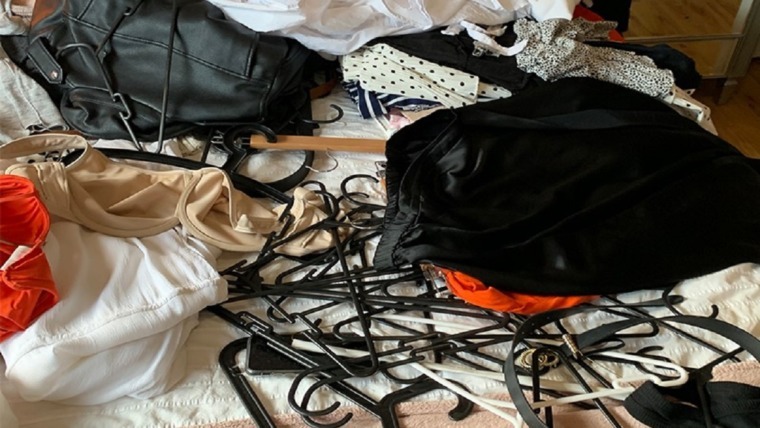
How To Repair & Repurpose Your Cloths
Written by Katrina Naish
If you have read our last articles How to Create a Sustainable Wardrobe & It’s Hard To Be Passionate About Fashion When… you will have noticed that we are passionate about making purposeful choices not only to ensure you look great but also to ensure your wardrobe’s carbon footprint isn’t leaving a devastating imprint.
One In 6 People Reported They Binned At Least 3 Garments Worn Only Once.
If you have watched reports like Foreign Correspondent’s White Dead Man's Clothes you will understand there is a huge problem and fast fashion has a lot to answer for. And while leading brands and governments need to act, they won't until they start to feel pressure from consumers.
But is fashion really the problem? It’s reported by Australasian Circular Textile Association that
For every 1kg of clothing Australian’s consume, we consume 2km of other textiles.
So, what can you do about reducing your textile consumption?
Don’t Follow Trends Blindly
This has a massive impact on the textile waste you produce.
We are not talking about just fashion here. Just think of all those cushions covers, linen, throws, towels and even the floor rugs/mats that are changing every time you restyle a room or you’re home.
If you’re keeping up with trends; fashion or home décor, it often means that your purchasing products that are priced at a more affordable price to entice you and make you believe that you can afford to update more regularly. BUT what hasn’t been calculated in the cost, is the cost to the environment (this is presuming it’s been ethically made, which is a whole other subject).
Once upon a time, people would only replace items when they were worn out. In most cases, this was because they couldn’t justify replacements if things weren’t worn out or no longer working. Because items weren’t mass-produced and priced to move quickly before the next product was in the door and needed to be sold. This in itself says something about the quality of products but also about the true cost of things and the perceived value.
We understand that technology has reduced the amount of manual labour that is required to produce products which have resulted in reduced costs. But the way they really reduce costs is by mass production. And the only way a business can move mass production is by selling to your desires and making you feel that you need to keep up with the trends.
It's time, that as a society we stop buying into the latest trends and remember that just because we can buy new products doesn’t mean we should.

Buy Into The Resale Market
In the past, there was definitely a stigma around purchasing second-hand clothing. But there has long been a market for second-hand tools, cars, machinery etc. Perhaps the reason is that clothing in many cases was a lot cheaper than these other items. However, the stigma around second-hand clothing is no longer there like it used to be. In fact, buying second-hand in many circles is considered cool.
There are so many websites, platforms. apps and stores that sell second-hand making it so much easier to buy and sell second-hand. And the good news is that the resale market is set to grow faster than the traditional retail market by 15% annually. So, it goes without saying that as it grows it will become easier and more efficient over time not to mention good quality items will hold their value longer. And the environment will thank you because the product’s life that your rehoming has been extended.
Extending The Life Of Clothing By Further 9 Months Would Reduce The Carbon Waste And Water Footprint By 20-30%.
The trick now is to change the mindset of looking at these sites first. And perhaps being a little more patient when you’re looking for that perfect dress or floor rug. And if you aren’t already selling your own products now is the time to start. You don’t want to be the only one not selling pre-loved items.
Repair And Repurpose
(This is our passion)
It’s no secret that for many years businesses have been designing products to be replaced. I remember my mother buying a new blade for a lawnmower and the sales assistant told her to take it home and fill in this hole/chip (pointing to the blade) with a welding join. Mum asked why and she was told that it will extend the life of the blade. It turned out that the business had done such a great job of designing the blade that they weren’t being replaced. So the business changed their blade design so marginally that the consumers wouldn’t realise and caused the blades to break. A simple design adaption increased their sales which were great for their business and the stockists but not for the customers hip pocket or the environment. These sorts of business practise coupled with the increased labour cost and mass production has resulted in the cost of fixing products not financially viable for consumers.
Reduce Textile waste
However, the cost of products that we are currently paying is not the true cost because businesses are not made to factor in end-of-life disposal. Businesses are starting to adopt take back systems but there are not yet enough of them as they have yet to see the value in doing so. Therefore we need to take matters into our own hands and either learn to repair and/or repurpose or seek out others that can. By doing this we will get the most for our money and lighten the impact on the earth, we need to be buying products that can be upgraded, repaired and repurposed, so their life is extended, and we are getting full use of them for a long time perhaps even a lifetime.
The good news is that if you’re not handy there is a solution. Around the world, there are Repair Cafes popping up everywhere. Most of these are volunteer-run and operate one day a month. You can take your product in and there will be skilled people to fix your product and sign off on it being safe or some even teach you how to fix it. Most times there are always people to help with repairing textiles because honestly in many cases these products are the easiest to repair.
Whether it’s individuals or businesses there is a surge in repurposing or upcycling. These people are taking waste products and giving them a new life before the product is recycled or ends in a landfill. In our option, these people need to be rewarded or at least supported for their actions especially if they are creating a product that solves a problem (other than reducing textile waste) or replaces a product made from raw materials.
The circular economy is being adopted around the world; some countries are doing better than others. Sadly, we think Australia is one of the slower ones, however, don’t let this deter you. Instead, see it as an opportunity to be a trendsetter; one trend that we fully endorse and challenge you to join us.
How To Repair & Repurpose Your Cloths How To Repair & Repurpose Your Cloths How To Repair & Repurpose Your Cloths



